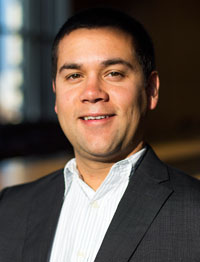
Assistant Professor Neil Dasgupta was featured as a “Shining Star of Solar” on the DOE-EERE website. The profile is included below:
Years participating in the EERE Postdoctoral Research Award Program: 2012-2013
Year of Ph.D. graduation: 2011
School: Stanford University (Ph.D.); University of California, Berkeley (for postdoc)
Employer: University of Michigan
Title: Assistant Professor of Mechanical Engineering
How would you describe your experience as an EERE postdoctoral awardee?
My experience as an EERE postdoctoral awardee was extremely valuable to my professional and personal development. The opportunity to join a group in a different field than my formal educational background (chemistry vs. mechanical engineering) helped to broaden my perspective on how to think critically about materials-related energy problems. I was able to bring in my background and experimental expertise to provide a new skill-set to the group, and learn many new hands-on experimental techniques, both in fabrication and characterization. Beyond broadening my technical expertise, I learned a lot about how to think about the same energy problems from a different angle, which was greatly enriched by my interactions with my research mentor and co-workers at UC Berkeley. My innovation project, which was to develop new energy-related coursework at Berkeley allowed me to interface with faculty and students from other parts of the university, and develop my teaching skills in interdisciplinary education. I also met many other colleagues in the energy field through conference presentations and the EERE postdoctoral award annual meetings, which set up the opportunity for future collaborations and helped me to establish a presence in the overall research community.
What was the focus of your postdoc research? Did you have any major findings?
My research focused on nanowire photovoltaics based on earth-abundant materials and low-cost processing. Specifically, we developed scalable processes for fabricating core-shell nanowire devices for solar energy conversion. My approach focused on the use of Atomic Layer Deposition (ALD) to precisely control the core-shell material dimensions, allowing for a quantitative exploration of material thickness phenomena including light absorption and charge separation. We developed fully functional photovoltaic and photoelectrochemical devices at the nanowire array and single-nanowire levels, to provide fundamental insights into the potential advantages of the nanowire geometry for solar energy conversion.
Do you think your EERE postdoc award played a part in preparing you for this position, or in making you more qualified for the job?
The EERE postdoctoral award played a critical role in enabling me to pursue my dream of becoming a professor at an excellent research institution. Having postdoctoral experience allowed me to broaden my portfolio of publications and content for faculty interviews, and helped me to develop my abilities to explain my research to a wider audience. The professional networking opportunities afforded by this program also allowed me to meet people that helped me to succeed along my path to an academic position, and will continue to be highly valuable in the next stage of my career.
What advice would you give to students who are considering applying for an EERE postdoc award?
Be ambitious and innovative in your goals and research project. Do not be afraid to propose challenging research, as this unique program will allow you to pursue high-risk, high-reward research that would otherwise be difficult to accomplish. Also, seek opportunities that are outside of your immediate expertise, it will help you to broaden your skill-set and perspective for future research endeavors.
Original article: http://energy.gov/eere/articles/shining-stars-solar-meet-three-sunshot-postdoctoral-award-recipients-who-are-making
